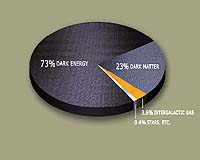 |
Paris, France (ESA) Jul 28, 2009 A team of researchers working with data from ESA's Integral gamma-ray observatory has disproved theories that some form of dark matter explains mysterious radiation in the Milky Way. That this radiation exists has been known since the 1970s, and several theories have been proposed to explain it. Integral's unprecedented spectral and spatial resolution showed that it strongly peaks towards the centre of the Galaxy, with an asymmetry along the Galactic disc. Several researchers have invoked a variety of dark matter to explain Integral's observations. Dark matter is thought to exist throughout the Universe - undetectable matter that differs from the normal material that makes up stars, planets and us. It is also believed to be present within and around the Milky Way, in the form of a halo. The recent study has found that the 'positrons' fuelling the radiation are not produced from dark matter but from an entirely different, and much less mysterious, source: massive stars explode and leave behind radioactive elements that decay into lighter particles, including positrons, the antimatter counterparts of electrons. The reasoning behind the original hypothesis was that positrons, being electrically charged, would be affected by magnetic fields and thus would not be able to travel far. As the radiation was observed in places that did not match the known distribution of stars, dark matter was invoked as an alternative for the origin of the positrons. But the recent finding by a team of astronomers led by Richard Lingenfelter at the University of California at San Diego, proves otherwise. The astronomers show that the positrons formed by radioactive decay of elements left behind after explosions of massive stars are, in fact, able to travel great distances, with many leaving the thin Galactic disc. Taking this into account, dark matter is no longer required to explain what Integral saw. A better understanding of how positrons behave has explained the mysterious radiation in our Galaxy. Share This Article With Planet Earth
Related Links Integral gamma-ray observatory Stellar Chemistry, The Universe And All Within It
 The "Invisible Universe" Exhibition/Symposium
The "Invisible Universe" Exhibition/SymposiumParis, France (SPX) Jun 29, 2009 At the dawn of this twenty-first century, cosmology is at a crossroads: 95% of the universe eludes observations. To evoke the mysteries of dark matter and dark energy the Laboratoire Univers et Theorie-LUTH (Observatoire de Paris-CNRS) marks the World Year of Astronomy with a series of events from June 29 to July 10 at the UNESCO Palace in Paris. Gathered at the initiative of LUTH's ... read more |
|
| The content herein, unless otherwise known to be public domain, are Copyright 1995-2009 - SpaceDaily. AFP and UPI Wire Stories are copyright Agence France-Presse and United Press International. ESA Portal Reports are copyright European Space Agency. All NASA sourced material is public domain. Additional copyrights may apply in whole or part to other bona fide parties. Advertising does not imply endorsement,agreement or approval of any opinions, statements or information provided by SpaceDaily on any Web page published or hosted by SpaceDaily. Privacy Statement |